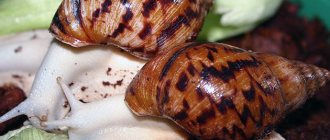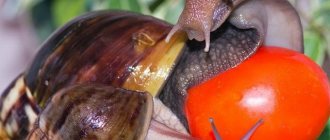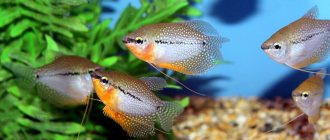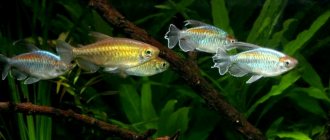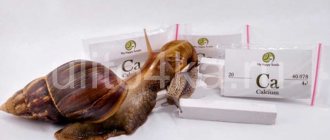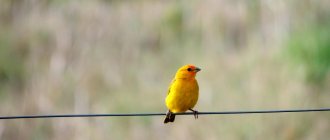General information about shellfish
Achatina are the most giant African snails.
They grow up to 30 cm in length. Their shells are large and have thick walls, and what color they will be depends on the food they eat. The shells have coils twisted clockwise and counterclockwise. Old snails have seven to nine such decorations on their shells. Small horns in the number of two pairs are the organs of touch of Achatina. Their eyes are located on the first pair of horns. With the help of light-sensitive cells found throughout the body, snails perceive light. Mollusks see objects at a distance of one centimeter from their eyes. They sense odors with their skin, and perceive the shape of objects located at close range with their soles. Snails breathe through their skin because they do not have lungs.
Snails need calcium to build their shells. Calcium is a very common chemical element.
Lack of calcium in the snail's diet leads to curvature and deformation of the shell. The snail shell becomes softer due to lack of calcium; it is not protected from the environment. Since all internal organs are attached to the walls of the shell, any damage to it can lead to improper functioning of the organs or death.
In order to prove how important calcium is for snails, I conducted an experiment.
Two groups of snails of the same age and species were taken and placed in the same conditions, but they were fed differently: some with food with added calcium, others with its complete absence.
Soon the snails of the second group stopped growing. It follows from this that calcium is indispensable for mollusks.
Snails kept in captivity receive calcium from sepia, eggshells, feed chalk, shell rock, gammarus, etc. For a more effective result, calcekashes are made. Calcekasha is a nutritious mixture made from various cereals with the addition of various sources of calcium; This product is served both dry and boiled.
Features of some snails
The largest species of snails include ampullaria. Its shell can reach 7 cm in diameter, and its leg up to 9 cm. The peculiarity of its structure is that it has a lid at the opening of the shells. Sensing danger, the snail hides, covering it behind itself. She also has a well-developed sense of smell, so when she smells food, she quickly goes to it.
Physes are small in size. The diameter of their shell does not exceed 2 cm. Their peculiarity is that they secrete a thread that connects the bottom to the surface of the water. This is where snails move.
Viviparous mollusks include melania. They like to hide in the soil, not allowing it to stagnate. They feed on what they can find at the bottom. Melanias reproduce in small quantities. About 50 cubs can be born at one time.
Nuances of breeding
Good offspring require patience, care and attention. It is recommended to learn how to care for Achatina eggs. The following nuances are also important:
- A large number of useful substances pass from the female to future offspring. Achatina grows poorly, the shell cracks. Therefore, you should not torture your pet if there is no need for breeding.
- Do not mate snails that are related or in poor health. Future offspring will be born with disabilities.
If there is no need for breeding, there is no need to torment the pet, since laying eggs takes a lot of nutrients from the female.
Achatina has no divisions into males and females. Mating occurs with the help of the genital organ located on the neck. A light spot in this place indicates that the individual is ready for fertilization. Snails are considered sexually mature when they are about 8 months old.
Achatina themselves determine who will bear the offspring. Usually a hardy, healthy and large snail is chosen for this role. In rare cases, both mated pets produce offspring.
Before you start doing this professionally and devote the next few years of your life to breeding Achatina snails, we would advise you to read the following information. So:
- Despite the fact that the reproduction of snails in nature proceeds without problems, at home you may encounter a number of difficulties.
- Pregnancy negatively affects the health of the snail itself, and there are often cases when, after laying eggs, the snail stops growing or grows very slowly. Therefore, if you are planning to raise a gigantic snail and want to have offspring from it, you will still have to give up one of these ideas. From which one? It's up to you to decide whether you want to have many small snails or one big and beautiful clam...
- Since the shells of eggs and the shells of small snails consist of calcium, which they borrowed from the mother’s body, the mother snail may begin to have problems with the shell - it may begin to peel and crack, and your Achatina snail will no longer look as attractive as it looked before .
- You must be prepared for the fact that snails are very prolific creatures and they lay hundreds of eggs in one clutch. And, now imagine, all these snails are hatching from eggs and you are faced with the problem of housing not 1, not 2, but 200 or 300 little Achatina, which, by the way, grow quickly and at the same time eat a lot. Therefore, think again - do you really want to breed such snails, and what will you do with them after they hatch from the eggs. Taking such a step just to see how small Achatina are is more than imprudent.
Achatina snails are hermaphrodites, that is, each individual has both male and female genital organs. In the absence of a partner, self-fertilization is possible, but it is quite rare.
The snail can store sperm for two years after mating, using it to fertilize maturing eggs. The number of eggs in a clutch is about 200 (in some cases up to 500); the snail can lay 5-6 clutches annually. The size of one egg is 4.5-5.5 mm, its shape resembles that of a chicken. Egg development is possible at temperatures from 22°C and lasts from several hours to 17 days.
How does reproduction occur?
Achatina snails mating
After the snails mate, Achatina becomes pregnant (mature individuals of the same species undergo the mating process) and she begins to lay eggs. As a rule, today all Achatina are oviparous creatures, although their gestation periods differ from each other, depending on their species. As for the gestating eggs, if desired, they can be seen through the spiracle of Achatina.
Well, on average, from the moment of mating to the moment the snail’s clutch is opened, 1-1.5 months pass. Although, there is evidence in the specialized literature that Achatina can also be viviparous. In other words, they do not lay eggs, but produce small snails, which they release in small groups.
Laying eggs
Achatina snails lay eggs in the ground; sometimes for these purposes they can dig a special hole, which is then sprinkled with soil. There are also cases when Achatina lays eggs simply on the ground. The number of eggs in the clutch itself can vary from several dozen to several hundred, but more often Achatina snails bring within 100 eggs.
It is noteworthy that after mating of Achatina snails has occurred, they are still able to lay clutches for a long time, even if you place them in different terrariums.
How snails mate
To avoid any problems when breeding and caring for Achatina snails, you should not mate mollusks from the same clutch, where they are all relatives to each other: parents, brothers, sisters, children. For breeding, healthy and large snails born in other families are selected. To ensure that the offspring are viable and healthy, one species and one variety of mollusks are mated.
If you plan to grow large snails, there is no need to rush into reproduction. This is due to the fact that during pregnancy the growth and formation of mollusks stops. Mating before individuals reach one year of age is undesirable.
Achatina iradeli or Lemon Achatina – useful information:
- Achatina iradeli is also called lemon Achatina because of the color of the shell. They are soft beige or lemon yellow.
- Iradels are not distinguished by their size; their shells reach a length of 6-8 cm;
- Adults and young animals thrive in glass and plastic cubic terrariums. The size of the aquarium is 5-6 liters for one adult lemon Achatina!
- African mollusks prefer peat, coconut substrate, forest mosses and sphagnum moss as substrate. Stale and rotten birch leaves are especially respected. The soil height is at least 8 cm; timid Achatina prefer to burrow into soft and warm litter!
- Viviparous snails require comfortable temperature and humidity. It is necessary to control t = 25-27 degrees using special devices and maintain humidity up to 80%. Daily spraying and periodic water treatments are mandatory for defenseless pets.
- Slow and calm iradels can get along in an aquarium with other snails, for example, with Limicolaria and Caracolius, but at the time of birth of offspring you need to be wary of being in the vicinity of individuals of another species.
We suggest you read: How snails reproduce in an aquarium: how they mate, how they give birth, how they reproduce
Lemon Achatina is not picky when it comes to food. Eats almost any vegetables and fruits, constantly needs mineral supplements and periodically protein supplements.
Reproductive system of Achatina snails
Achatina genital organ on the neck
As a rule, Achatina snails reach the peak of their sexual maturation when they are 6 months old. True, a small gap is possible: a month, or a month, but this is more likely connected not with the physiology of the mollusks, but with the conditions in which they live and what they eat. It is noteworthy that the snail’s genital organ is located on its… neck.
Therefore, if you doubt whether your snail is ready to mate, just examine the neck of the mollusk, there should be a small reproductive organ, which is also called the arrow of love. It looks like a small, light-colored tubercle. So, if you find such a spot on your pet’s neck, don’t be alarmed, this is not a sign of illness at all, but a sign that the snail is ready to give birth.
As for the issue of sexual differences, Akhtina snails belong to the class of hermaphrodites. However, in order for them to give birth, they still need a mate. As for possible cases of self-fertilization, fortunately for us, they are extremely rare, therefore, if you have 1 snail and it will bring you offspring, there is no need to worry. In theory, this shouldn't happen.
How to care for small snails
After birth, small Achatina snails do not need a separate terrarium from their parents, as they are very friendly towards everyone. The only time you can try to separate the “children” is in a situation where the terrarium is oversaturated with such snails. In such cramped conditions, little Achatina will not be cozy or comfortable; they will not be able to fully eat, grow, and develop. It is especially necessary to be careful during such a move in relation to the mollusk shell.
As for the moment when it is still possible to separate the offspring of snails, experts recommend doing this before the snail reaches puberty and is ready to mate. After that, you will already be late, and you will become a happy “grandfather” or “grandmother” of little snails. By the way, experts say that a snail can lay eggs even after several months from the moment of mating. Moreover, one contact is enough for such a snail to lay clutches several times...
Small Achatina snails - maintenance rules
After the tiny Achatina are born, they remain for some time in the depths of the terrarium substrate where the clutch was located, and only a few days later, in small “batches,” they make their way to the surface. What happens to eggshells? Small snails eat it, so you probably won't have to clean it up. Well, how soon they appear on the surface of your terrarium will depend on the depth of the masonry and the density of the substrate.
Usually, “snails” are kept with their parents, but if the terrarium is overcrowded, then it is better to separate them. Caring for young snails is generally the same as for adult snails, but they need constant access to food for active growth and development. You need to be especially careful when handling their shells while they are fragile.
How to raise snail eggs
Snails have healing properties. It is believed that their meat can cure tuberculosis.
Many Achatina owners believe that snails can distinguish their owners from other people. Watching Achatina is very peaceful, as is watching fish.
Place the snails in any transparent container so that they are clearly visible. They are usually kept in a terrarium. One snail should have 10 liters of terrarium volume. Read more about how to keep snails at home below.
We suggest you read: Flea shampoo for cats, composition and which one to choose
The container containing snails must be closed with a lid with holes for air access. Otherwise, the snail may escape from its house. When it finds itself in an unfavorable environment outside its habitat, it hibernates, and then it is very difficult to find it.
The comfortable temperature for Achatina is 25-28 degrees, because it is a tropical animal. At room temperature it will live, but will become inactive. For heating, you can use a tape or flat terrarium heater, which is sold at a pet store.
Snails do not need bright light; they live in the twilight of the tropical forest. Excess light can dry out the snail's body.
To make Achatina feel at home in your terrarium, you need to spray the walls with a spray bottle 1-2 times a day.
The main thing in keeping Achatina is to monitor the soil moisture; it must not be over-moistened or over-dried.
You can control humidity by the behavior of Achatina. If they try to climb up the side of the terrarium, the soil is too wet. If snails seal their shells and hibernate, the climate is too dry for them.
You can take advantage of this feature of snails to hibernate when leaving home for a long time during a business trip or vacation. You can wake up your pet by holding it under a gentle warm stream of water or by increasing the humidity in the terrarium.
At the bottom of the terrarium there should be soil 5-10 cm deep so that Achatina can burrow into it to lay eggs. The soil needs to be loose. For this, ordinary soil with the addition of sand, coconut substrate, and the bark of coniferous trees is suitable.
Achatina's bedding must be changed as it gets dirty. The walls of the terrarium should be wiped with a damp cloth once a month.
In addition to caring for the snails’ habitat, you need to ensure the cleanliness of the mollusks themselves. Achatina also needs to be washed from time to time. Snails love to be bathed in warm water. After holding the snail in your hands, you should wash your hands with soap.
In the terrarium in which the snails live, you need to install a container with water into which the Achatina can climb themselves and crawl back out. This should be a shallow container so that the snails do not drown there. And it must also be heavy so that it does not tip over when a mollusk crawls in there or buries itself nearby to lay eggs. The water in the container must be changed once a week.
The size to which a snail can grow depends on its species and the size of the terrarium. If it has a large volume, then the snail will grow large.
Achantinas are most active at night. During the day they usually sleep in a secluded place. To do this, you need to put stones, driftwood, and coconut shells in the terrarium.
It is good if live plants grow in the terrarium. They create a microclimate, secluded places for snails and serve as additional food.
All care consists of changing the water in the container once a week, changing the soil once a month, and cleaning the glass of the terrarium once every 3 months.
Snails live a long time, up to 10 years. They begin to reproduce at six months of age. One Achatina can lay up to 100,000 eggs in its life. This productivity is used to organize commercial snail breeding farms. After all, France buys millions of dollars worth of them for food. But how to breed Achatina?
Achatina reproduces in captivity without problems. These mollusks are hermaphrodites, that is, they can reproduce by self-fertilization in a small population. But if there are several individuals in the terrarium, then you can observe the courtship dances of snails.
The larger snail acts as the female. Young snails can only perform the functions of males.
An interesting and unusual feature of Akhantina is the training clutch. Young snails, having reached 6-8 months, lay clutches of 10-15 unfertilized eggs, as if training for real reproduction.
After mating once, a snail can lay clutches with fertilized eggs more than 10 times, doing this 6 times a year. Sperm remain alive in the snail's body for more than 2 years, constantly fertilizing growing eggs.
1-2 weeks after fertilization, the snail digs a hole in the ground and lays several hundred light-colored eggs. After 1-3 weeks, small snails 5 mm long hatch.
It is necessary to pay attention to feeding small Achatina. There have been cases when babies died after being glued to a large piece of banana.
It is necessary to clean the terrarium with masonry without using water, so as not to change the humidity in the location of the masonry. It is better to keep small snails in a separate terrarium without soil. Instead, it is better to cover the bottom of the terrarium with cabbage or lettuce leaves.
- onset of puberty;
- suitable partner;
- a nutritious and varied diet;
- maintaining optimal temperature and humidity in the terrarium;
- complete replacement of the soil with a new one.
The African snail is kept in a terrarium, aquarium or plastic container with transparent walls. Thus, detecting Achatina eggs will not be difficult. Snail breeders often find a clutch of mollusks at the bottom of the container. Take note of this and once a week lift the container up and inspect its bottom.
Look at the photo how clearly the masonry is visible at the bottom of my terrarium.
Since the African snail is an “exotic guest”, it cannot live in our harsh climate. Yes, and placing small snails is always a difficult and troublesome task. Therefore, it is better to freeze the Achatina clutch in the freezer for several days.
If you decide to propagate the African snail, then carefully collect the Achatina eggs with a spoon. Adult snails can tear apart or crush the clutch, resulting in the death of all embryos. Prepare a small plastic box, add some damp soil and dry leaves.
Place the egg clutch on this bedding, cover it with soil and sprinkle a little warm water on top. Then close the container tightly (the eggs do not need air), and be patient.
You can read more information in the article about the maintenance and cultivation of Achatina egg laying. In a few days or weeks, the entire soil will move from the “swarming” of small African snails. The babies are hatched as smaller versions of their parents - with a shell, horns and a wonderful appetite.
The Achatina snail is bred at home as an unpretentious pet and as additional income. Mollusk mucus is used for rejuvenating cosmetic procedures (snail therapy), and its meat is valued for its dietary and taste qualities.
In anticipation of offspring, it is necessary to create conditions for the reproduction of Achatina snails. The aquarium should always have a constant temperature of 27-28 degrees. Her hesitation during this period is unacceptable.
In order to cover the bottom of the snail house, a coconut substrate is used, but not dry, but wet. Its thickness should be 10 cm. The aquarium itself must be cleaned regularly, and the snails must be fed with calcium.
Using sepia, chalk or mineral stone, small shell rock is what you need. The snail should be provided with nutrition containing calcium before the onset of pregnancy, during it and after it, until the mollusk recovers.
To reproduce Achatina snails at home, they must mate. For this to happen, they are transplanted into another aquarium or container. If the individuals have the same size, fertilization will be bilateral; if their parameters do not match, fertilization will be unilateral. The snail whose size is larger becomes a female.
Mollusks at a young age produce more male reproductive cells than female ones. For this reason, for the breeding process, young mollusks are placed with adults.
We suggest you read: The most common diseases in cows and bulls
Mating of snails lasts two hours or a little less. With their genital organs they come into contact with each other, exchanging sperm and becoming fertilized. The body of the mollusk can store it for two years. A snail can lay eggs every month if the conditions are favorable for this.
After mating, egg laying begins. It is currently known that all Achatina snails are oviparous, although they differ in terms of gestation. The gestating eggs are clearly visible if you look in the spiracle of the mollusk. From the moment mating occurs until the opening of the clutch, one to one and a half months pass.
Many novice breeders are faced with this problem: despite the good maintenance of the Achatina snail, reproduction still does not occur. What to do? You need to start by making sure that the shellfish are healthy. If everything is in order, their feeding regime and the composition of the diet are checked.
Next, the conditions of detention, the thickness of the substrate in the aquarium and its condition are examined. If the litter has not been changed for a long time and it has become dirty, there will be no mating and further reproduction of Achatina snails in such conditions. Experienced breeders stimulate the breeding process by removing the artificial pond.
Everything is important in shellfish farming, but the process of reproduction is the beginning of life. Therefore, you need to create the most comfortable conditions for this. Another, no less important point is egg care. Achatina snails, which have been reproduced according to all the rules, very soon cover the bottom of the aquarium with white eggs.
After 65 days, snails will hatch from them. For some time they will live in the ground, feeding on eggshells. An adult lays an average of 50 eggs with a diameter of five millimeters. When breeding the Achatina snail, caring for the eggs is simply necessary. If you leave the clutch unattended, they will die. Therefore, the following rules for caring for them should be observed:
- The soil bedding at the bottom of the aquarium should not dry out, but the accumulation of liquid is also unacceptable. If water covers the nest, the eggs will rot, and all the embryos will die in dry soil.
- You can sprinkle the eggs with soil to keep them safe.
- Humidity should be maintained higher than usual.
- Throughout the entire period of masonry, the temperature regime must be observed. The aquarium should be warmer than the room.
- You should not keep a large number of snails in one house. In cramped conditions, eggs often die.
- They should not be touched with hands, otherwise the shell may be damaged.
Achatina snails mating
Creating conditions for snail breeding
In order for the snails to mate in the best way, as well as for laying eggs, you need to create the necessary conditions for your pets. The temperature regime should be +27-+28 degrees. You also need to moisten the coconut flooring at regular intervals.
Snails should be given calcium before the breeding process. Chalk, shell grits, mineral stone, and egg shells are quite suitable for obtaining calcium. Calcium must be constantly present during gestation and egg laying.
The female is in the pregnancy stage for 30-45 days, at the end of which she lays a clutch of eggs, amounting to 200 to 300 pieces. Babies will be born after 14-22 days.
5 / 5 ( 1 voice )
Reproductive system of Achatina snails
Taking care of pets is easy. But there are a few rules that will help you not get confused:
- eggs should always be in the ground;
- control the temperature in the terrarium;
- Constant soil moisture is recommended;
- when moving eggs to another house, they should be taken with a spoon along with the soil, transferred and covered with damp soil;
- do not expect offspring from the entire clutch;
- After laying, it takes about a month for the babies to hatch.
Large individuals take care of their offspring themselves; you should not disturb them. It is recommended to monitor them, and when they reach sexual maturity, place them in a separate house. If this is not done, Achatina will continue to reproduce. After the offspring hatch, the newborns begin to crawl out of the ground.
If the clutch of Achatina eggs is too large, some can be frozen.
A large food container, terrarium or glass aquarium with a wide bottom is used as a “house” for the African snail. Remember, to grow a large snail, you need a large “house”; snails do not like cramped spaces. It is believed that for 1 adult snail you need a container with a volume of 15-20 liters. Be sure to equip the container in which your clam will live with a lid so that it cannot escape.
African snails are terrestrial animals, so soil substrate is used to keep them at home. Mollusks are nocturnal animals; they prefer to sleep during the day, burrowing into the ground. The following soil is used: coconut substrate, moss, flower soil well washed from fertilizers. The soil in the terrarium should not be dry; it should be irrigated with clean water once a day. But don’t overdo it, you shouldn’t create a swamp.
Achatina snails need fresh air, so take care of proper ventilation in the terrarium, since the snails will get dirty in the dirt and stain the glass. Sometimes snail breeders add a little sand or dry leaves to the coconut substrate. More details about soils here.
To avoid unpleasant odors, midges and parasites, domestic snails must be kept clean. Leftover food and excrement must be removed every day. Wash the ground bedding and glass once a week, and carry out general cleaning of the terrarium every 3-6 months. Remember, the more often you take care of your pet’s home, the better.
In natural light conditions, Achatina feels good. They do not need additional lighting. Alternating day-night mode is sufficient. House snails are active only at night. Most often, lighting devices are installed to monitor shellfish and additionally heat the air.
Achatina snails are temperature dependent, so make sure it is constant. For keeping an African snail at home, the most optimal air temperature is 24-28 degrees. If the temperature is lower, Achatina becomes lethargic, eats little and spends more time in the sink.
It is not advisable to install a terrarium with a snail near a battery or on a windowsill in direct sunlight. Your pets can die from overheating.
You can add a little zest to the interior of the terrarium. For example, plant living plants, dig a shallow container of water, spread moss or pieces of bark. Use half a coconut or a plastic flower pot as a shelter for the snail.
Feed the snail once a day (in the evening). Achatina prefer plant foods. They love lettuce, dandelion, grapes, cucumbers, and apples. They also eat spinach, corn, zucchini, mango, avocado, bananas, and melon at home.
However, the snail can eat some of the listed products, and refuse some altogether. You should not often give oranges or grapes, watermelon with seeds. Some pets eat carrots and cabbage. Healthy carbohydrate foods for shellfish include oatmeal flakes, bran and various delicacies.
STRAWBERRY MUSHROOMS CUCUMBER PEPPERS SALAD PLAINLAND CABBAGE WATERMELON
In the first year of life, snails grow rapidly. In order for their shells to grow quickly, they need food supplements. Calcium carbonate helps strengthen and grow the shell. Crushed eggshells, a piece of edible chalk or sepia should always be present in the aquarium in abundance.
African snails should not lack calcium supplementation. Sepia and edible chalk are sold at pet stores, and eggshells are always available in abundance in every home.
Do Achatina snails need water? Very. Snails drink it by licking it from the walls of a container or shallow pool. Water is useful for normalizing mucus production. Some snails allow you to pull yourself together and bathe them in a bath of warm water. They love water and are not afraid of it. However, make sure that your pets do not drown by bathing them in a shallow dish and under your supervision.
African Achatin snails become sexually mature at 7 months. An enlarging white tubercle on the neck of the mollusk signals its readiness to reproduce. The better the living conditions, the faster the mollusk will become sexually mature. All domestic snails are hermaphrodites, so after mating, each will lay a clutch of eggs.
We suggest you read: Why does a cat have dilated pupils? Is this normal?
By the way, for laying you need a layer of soil of at least 7 cm, since the litter serves as an incubator for eggs. If the soil thickness is small, reproduction may not occur. Incubation of the eggs lasts 1 month, after which tiny snails hatch.
Achatina are very prolific and can lay 4-5 clutches per year. Such a quantity is difficult to maintain, expensive to feed, and sometimes there is no one to distribute. Therefore, it is better at the embryonic level than to later get rid of live snails in an inhumane way.
By the way, Achatina eggs are eaten, used for cosmetic purposes and as a calcium supplement for adult mollusks.
The most common problems are mechanical in nature. Damage to the shell when a shellfish falls in a terrarium, in the bathroom, gnaws on the shell. Don't despair, the sink will soon recover. The main thing is to increase the amount of calcium supplement and monitor the cleanliness of the snail.
Lubricating the sink with a solution of manganese or iodine helps prevent gnawing.
Many snails are shy in themselves and do not make contact well. Therefore, accustom them to your hands. Wet your palms with water, place your finger under the body, and with your other hand help the snail move onto your palm.
Other diseases often arise due to poor care or neglect of pets and their food. For example, snail hibernation can be caused by poor living conditions. The mollusk hides in the shell and seals the entrance. All this time he lives off previously accumulated energy reserves. If it is not awakened in time with warm water, the mollusk will die.
Keeping a giant Achatina at home does not require special skills; even a child can easily cope with it. Therefore, do not miss this opportunity to please yourself and surprise your loved ones with such an unusual and exotic pet.
Achatina are huge land snails that live in the tropics and subtropics. Gradually, with the help of people, they spread from Africa to the countries of Southeast Asia with a warm climate. There they took root and multiplied, turning into pests that spoil many young crops, almost completely eating them.
Natural snails can be a source of infectious diseases that are dangerous to humans. But Achatina bred at home are harmless; they do not have dangerous viruses.
In Japan, Achatina is bred for consumption. In France, they are also eaten, like grape snails.
In Russia, Achatina are common as pets; they can survive the winter only at home. Snails are widespread as they reproduce quite easily.
The size of these snails reaches thirty centimeters, and the shell is 25 cm. The mollusk has a heart, one kidney, lungs, a brain and two eyes. They can breathe through their skin, look at a distance of no more than 1 cm and hear nothing. But they sense odors very well, over the entire front surface of the body.
The patterns on the sink vary. In addition, the pattern may change depending on the nutrition of the mollusks.
More than 100 species of achatite are found in nature. They all have a similar diet, behavior, and require the same care. Below we will tell you how to determine the type of Achatina.
Fulica is a type of giant Achatina snail. This is the most common type of East African snail because it is very easy to care for. The snails have a beautiful variegated shell and a brown, muscular body with characteristic tubercles.
They are slow and like to spend a lot of time sitting still.
Reticulata is the second most common type of Achatina snail for home keeping. The pattern on the shell has stripes and dots, the snail's leg is dark, almost black with a white border.
Snails are very active and curious, often raising their heads to look at their surroundings.
Hobbyists also breed other types of Achatina: Glutinosa, Immaculata, Iostoma, Shtulmany, Iradel, Tinkta, Zanzibarika.
They differ in size, the color of the snail's body and shell, the shape and color of the stripes on the shell, and the shape of the shells.
Snails move slowly. It is clear that they feed on whatever comes their way. It is advisable that fresh herbs are constantly near the shellfish. Snails can be given small pieces of any vegetables and fruits that their owners eat.
Clams love to eat greens. Salads and cucumbers are fed to them all year round. Vegetables, fruits, herbs, champignons - all this goes to their food. In summer you need to add wild herbs: plantain, dandelion, clover.
Achatina craveni - rare viviparous snails
Today, experienced breeders have acquired new exotic specimens of African beauties. Among the new, little-studied species for home keeping, Achatina craveni also appeared. These are viviparous Tanzanian snails with an unusual striped shell color.
Such species are very attractive to fans of slow and unpretentious creatures. Cute individuals get used to their owners and grow quickly. In order to bring a few healthy offspring after a year of quiet, measured life.
Breeders of African mollusks dream of acquiring one of the viviparous species. After all, every owner wants to watch the miracle of the birth of “ready” formed babies. However, this form of reproduction, which does not require incubation of egg clutches, is especially popular with experienced breeders. There is no need to care for eggs, constantly monitor hatching and freeze unnecessary eggs.
Under home keeping and breeding conditions, all Achatina snails readily reproduce. But experienced breeders find markets and take care of the babies for the purpose of future profitable sales. Sending numerous healthy broods by mail! They are carefully packaged in airtight containers with small holes for air to send the boxes into the good hands of their new owners.
conclusions
Today we talked about the reproduction of Achatina snails and how to do it professionally, what living conditions need to be provided for these mollusks so that you can count on their healthy offspring. Well, now, after our publication, you can answer your question - do you want to breed Achatina snails, or are you ready to be content with keeping one large mollusk.
Have you ever seen a clutch of Achatina snails? What difficulties have you encountered in the process of breeding snails? Share your experience with our readers in the comments to this article and on the pages of our VKontakte group...
We are waiting for your feedback and comments, join our VKontakte group!
How can you stimulate the reproductive processes in Achatina snails?
Sometimes you can hear snail owners say that they seem to be doing everything right, but the long-awaited offspring of Achatina are still missing. Why, they asked, what are we doing wrong? In this case, if the Achatina snails themselves are completely healthy, you provide them with a balanced diet and mineral supplements, we would recommend that you pay attention to the living conditions of your snails. What is the thickness of the substrate in the terrarium? If it is less than 4 centimeters, then the snails simply have nowhere to lay their eggs. If the soil is dirty, Achatina is also unlikely to reproduce in it. Therefore, sometimes it is enough to simply put things in order in the terrarium and do everything according to the rules, and after a few weeks, you will be able to observe the small Achatina snails with which your terrarium is simply teeming.
What to do if you didn't plan for so many eggs
If your Achatina turned out to be surprisingly fertile, but you never expected that there would be so many eggs, given that from this number of eggs an average of at least 70% of living Achatina individuals will appear, you can “thin out” their ranks a little. True, you are unlikely to be able to predict in advance which egg will be empty and which will bear healthy offspring. It is recommended to do the following with excess eggs - freeze them and then throw them away or boil them. Don't just throw them in the trash. Achatina, despite fate, can still hatch, and then their uncontrolled reproduction will begin.
Although, for the future, I would like to say that you must be prepared for the fact that there will be a lot of offspring, therefore, you must realistically assess your capabilities both to provide this number of snails with decent living conditions, and to ensure that they have a chance of adoption.
Selection of breeding snails
If you seriously decide to further breed Achatina snails, you will need to carry out a breeding selection among them. Choose strong, healthy and large Achatina for breeding. They will form your tribal core. Those snails that you simply plan to grow large are best kept separately from the rest...
Video on the topic of reproduction of Achatina snails:
How to stimulate spawning
The snail breeding process must be approached responsibly. They need strict adherence to water temperature. It can range from 25° to 28°. Sudden changes in temperature should not be allowed.
You need to line the bottom of the aquarium with coconut bedding. Sometimes during gestation the snail's shell may burst. To prevent this from happening, a little calcium is added to her diet daily. If all conditions are met, mollusks reproduce every 3-5 days.
Reproduction methods
In the case of breeding mollusks of different sexes, a female and a male are placed in a separate aquarium. This will ensure their mating. Heterogeneous species of mollusks include:
- tiger snails;
- pagodas: ordinary and brotia;
- neritines: red dot and freshwater;
- Maryse.
After visiting a separate aquarium, they need to be fed generously and the water temperature slightly increased.
Same-sex species include:
- coils;
- tuberous melonoides;
- tropical pond snails;
- Phys.
They have no gender differences. In an aquarium, the role of the male is played by a larger mollusk, and the female is correspondingly smaller.
The outer shell of their caviar is quite dense, so fish cannot eat it.
Laying eggs
There are snails that do not need a mate; they are same-sex. Even if there is only one individual in the aquarium, after a while it will give birth to offspring. Snail eggs are laid on algae leaves, aquarium walls, pebbles and decorative items. The masonry cannot be moved to another place. This will lead to the death of the offspring.
Ampullaria snails lay their eggs slightly above the water level. At first, the masonry resembles transparent jelly. After a short period of time it darkens and acquires a brown tint. The color indicates that babies are coming soon.
The ampularia eggs have hatched and you can already see the tiny snails.
Some types of snails bury themselves in the sand and remain there until the eggs hatch. Up to a hundred babies can hatch into the world.
Maryses are heterosexual. Males have a light leg with brown spots, while the female has a darker leg. They can mate for up to 10 hours; the eggs are attached to plants. The clutch appears every 4 days. The birth of mollusks occurs after a week.
We invite you to read: Piglet breeding business plan and profitability
It's hard to build a pagoda. This is a viviparous snail. She bears offspring for a month and gives birth to them once a year. Young animals have a high mortality rate.
Snail pagoda. Beautiful, but difficult to reproduce in captivity.
Tilomelania needs a separate reservoir for reproduction. She only bears a couple of eggs at a time.
